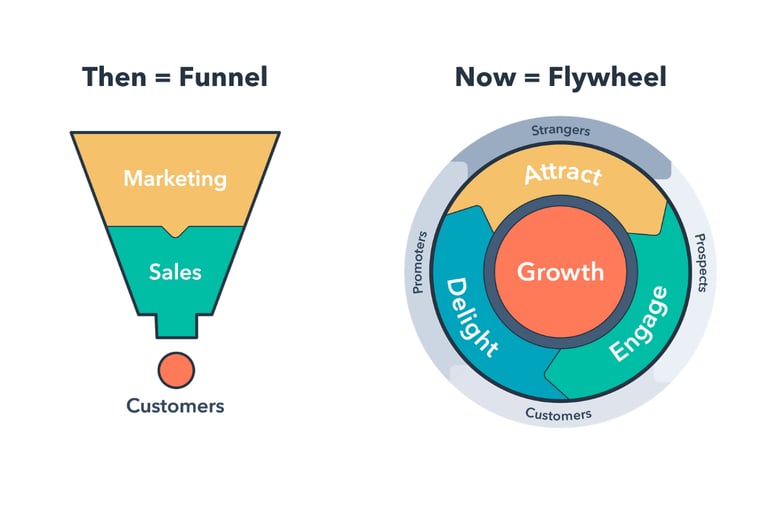Building a Mutually Beneficial B2B Journey
Uniting your sales and marketing teams can drastically improve your customers’ experience with your brand — and your bottom line. However, achieving optimal sales + marketing (smarketing) alignment can feel virtually impossible without the right tools or tactics.
This guide was designed to provide your marketing and sales teams with partnership-building tactics to create customer experiences that are just as rewarding to your teams as they are to your customers.
Inside, you’ll find smarketing best practices and attainable strategies to help you foster growth-driven collaboration and continue delighting your customers at every stage of the marketing and sales process.
Balancing the B2B Customer Experience
Digital experiences have created a world where customers can learn about, engage with, and demo products or services in just a few clicks. Your prospects have access to unlimited information about your brand and its products, and they expect a cohesive, on-brand experience no matter where or when they come in contact with your brand.
These future customers might follow the traditional buyer's journey, learning about your brand online and receiving several marketing emails before scheduling a demo with your sales team. Or, they may leverage the breadth of knowledge at their fingertips to chart a unique path from contact to SQL — by reading customer reviews or downloading bottom-of-funnel marketing content before ever hearing from your marketing or sales teams directly.
Gone are the days of winning business just because of your market presence, the cost of your services, or the success of your sales team alone. Rather than focusing solely on their individual goals, modern sales and marketing teams must work together to develop customer-first experiences that resolve customers' pain points and meet them exactly where they are in their buyer's journey.
Sales + Marketing = Better Together
At its core, your sales team’s job is to qualify prospects, build relationships with those prospects, and provide them with solutions that support their goals or resolve their pain points. Your salespeople must be invested in the success of your current and future customers. They must understand prospects’ challenges and clearly articulate why your products or services are the best solutions to those challenges.
86%
Eighty-six percent of marketing professionals spend
their efforts on accounts that the sales team is
targeting.
But before your sales team can begin engaging with prospects, they need a list of qualified leads to pursue. Your marketing team’s job is to educate the market about your solutions, then generate interest around them in a way that resonates with your audience. Marketing relies on a careful balance of human emotion and data analytics to spread the word about your brand and convert curious contacts into qualified leads that fuel your sales pipeline.
87%
Eighty-seven percent of sales and marketing leaders say collaboration between sales and marketing enables critical business growth.
As buyer’s journeys evolve, the line between these two departments continues to blur. Your sales team might be contacted by someone who’s self-nurtured by reading all of your digital marketing content, or your marketing team might want to re-engage existing leads in your pipeline.
Your marketing and sales teams need to be in close alignment to ensure your company can effectively reach buyers on their terms. Traditional sales and marketing tactics are becoming less and less effective. In their place, cross-functional alignment and collaboration are the keys to scalable growth — and a top-tier customer experience.
What is Smarketing?
The term “smarketing” was coined by HubSpot in the early 2000s. As the name suggests, this now-popular concept describes the alignment between sales and marketing teams created through frequent and direct communication between the two.
Smarketing = sales + marketing alignment through constant communication.
Smarketing helps sales and marketing teams create measurable goals that hold everyone accountable and contribute to your organization’s bottom line. For example, they might work together to define a leads service level agreement (SLA) for marketing, with the contingency that sales must follow up with a certain number of the leads they receive.
Smarketing paves the way for sales and marketing teams to:
- Work together on individual and shared goals that improve the customer experience.
- Establish mutually agreed-upon SLAs to govern and hold both teams accountable.
- Re-evaluate their goals every month to identify opportunities for improvement on both teams.
Set Strategic Smarketing Goals with HubSpot’s Goal Calculator
HubSpot’s Marketing & Sales Lead Goal Calculator makes it easy to calculate, share, and track progress toward cross-functional goals with an SLA.
Each team will still have unique key performance indicators (KPIs), but they should ultimately work together to reduce friction and champion customer-centricity. Smarketing’s foundation lies in transparency, which means both shared and individual goals should be openly discussed and rooted in customer experience.
Benefits of Smarketing
- Fewer unqualified leads
- Higher sales win rates
- Shorter buying cycles
- Easier deal closings
- Increased customer retention rates
- Faster revenue growth
When it’s done right, this collaboration produces consistent customers experiences that attract, engage, and delight buyers on a unified front.
